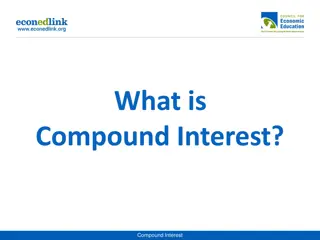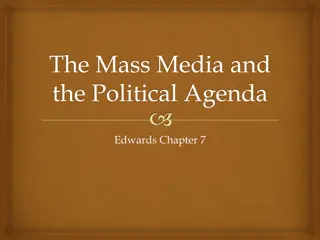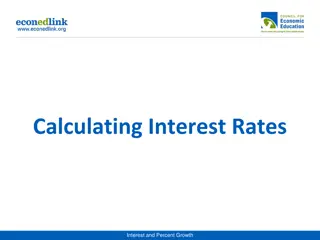Understanding Interest Groups in Politics
Interest groups are organizations of people with shared policy goals who seek to influence the policy process without fielding candidates for office. They operate in various arenas and specialize in particular policy areas. Examples include AARP, Sierra Club, NAACP, ACLU, and NRA among thousands in the US. These groups play a significant role in shaping government decisions and policies.
Download Presentation

Please find below an Image/Link to download the presentation.
The content on the website is provided AS IS for your information and personal use only. It may not be sold, licensed, or shared on other websites without obtaining consent from the author. Download presentation by click this link. If you encounter any issues during the download, it is possible that the publisher has removed the file from their server.
E N D
Presentation Transcript
Interest Group An organization of people with shared policy goals entering the policy process at several points to try to achieve those goals. Interest groups pursue their goals in many arenas.
Interest Groups Interest groups are distinct from political parties. Political parties fight election battles; interest groups do not field candidates for office but may choose sides. Interest groups are policy specialists; political parties are policy generalists. Interest groups can access, or influence many points and levels of government
Interest Group Examples AARP (American Association of Retired People) Sierra Club (Environment) NAACP (National Association for the Advancement of Colored People) NOW (National Organization of Women) ACLU (American Civil Liberties Union) PIRGs (Public Interest Research Groups) NEA (National Education Association) AMA (American Medical Association) NRA (National Rifle Association) Thousands of interest groups in the US
United Auto Workers (UAW)
American Civil Liberties Union (ACLU)
American Association of Retired People (AARP)
National Association of the Advancement of Colored People (NAACP)
NRA You can have my guns when you take them from my cold, dead hands. Charlton Heston, Moses, Actor, former President of the National Rifle Association
Peoples Society of Secretly Communist Teachers Posing as Conservatives
Interest Group Politics Are interest groups good or bad? Pluralist Theory Competition among groups trying to get their preferred policies. Elite Theory Upper-class elite holds most of the power and run government. Hyperpluralist Theory Groups are so strong that government is weakened.
Interest Groups and Pluralism Theory Groups provide a link between the people and the government. Groups compete and no one group will become too dominant. Groups play by rules the game. Groups weak in one resource may use another. Lobbying is open to all groups, regardless of group size or strength.
Interest Groups and Elitism Theory Groups are unequal in power. Awesome power is held by the largest corporations. Power of a few is fortified by interlocking directorates. Other groups win minor policy battles, but corporate elites consistently win the big decisions.
Interest Groups and Hyperpluralism Interest groups causing political chaos TOO MANY GROUPS,TOO MUCH INFLUENCE Government trying to please everyone, resulting policies are contradictory and confusing Ex. support removing manufacturing regulations and support environment protection??? impossible
What makes Interest Groups powerful? Size (sometimes stay tuned) Power of AARP 25% of the population 50 and over Intensity drive or effort put forth (single issue groups fall into this category) Money form a PAC (Political Action Committee) donate money to campaigns and advertising
Surprising Ineffectiveness of Large Groups Potential group People who might be group members because they share some common interest. Actual group Potential group members who actually join group. Collective good Something of value that cannot be withheld from a potential group member.
Surprising Ineffectiveness of Large Groups con t Free-rider problem Problem of people not joining because they can benefit from the group s activities without joining. Selective benefits Goods that a group can restrict to those who actually join.
Intensity of the Members A large potential group may be mobilized through an issue that people feel intensely about. Politicians are more likely to listen a group that shows it cares deeply about an issue. Single-issue groups Narrow interest, dislike compromise, and members are new to politics.
Money, Money, Money Not all groups have equal amounts of money. Monetary donations translate into access to the politicians, such as a phone call, meeting, or support for policy. Wealthier groups have more resources and access, but they do not always win on policy.
How do Interest groups get money? Donations (YOU!) Membership dues (also YOU!) Foundations Ex. - Bill and Melinda Gates Foundation, Ford Foundation Federal grants and contracts
How Interest Groups Work to Influence Policy Lobbying Communication to a governmental decision maker with the hope of influencing his or her decision. Lobbyists are (1) a source of information (2) helping to get legislation passed (3) helping to formulate campaign strategy (4) a source of ideas and innovations.
How Interest Groups Work to Influence Policy Electioneering Direct group involvement in the electoral process by helping to fund campaigns, getting members to work for candidates, and forming political action committees (PACs). PACs are political funding vehicles created by the 1974 campaign finance reforms.
How Interest Groups Work to Influence Policy Litigation Amicus curiae briefs Written arguments submitted to the courts in support of one side of a case. Means Friend of the Court Class action lawsuits Enable a group of people in a similar situation to combine their common grievances into a single suit.
How Interest Groups Work to Influence Policy Going Public Groups try to: (1) cultivate a good public image (2) build a reservoir of goodwill with the public (3) use marketing strategies to influence public opinion of the group and its issues (4) advertise to motivate and inform the public about an issue.
How Interest Groups Work to Influence Policy
How Interest Groups Work to Influence Policy Ratings Game Interest groups will monitor the voting record of legislators, particularly on controversial bills They assign and publish a grade for each politician based on how well their voting record matched the policy goals of the interest group
Types of Interest Groups Economic Interests Labor Union organizations press for policies to ensure better working conditions and higher wages. Business Interests generally unified when it comes to promoting greater profits but are often fragmented when policy choices have to be made.
Types of Interest Groups Environmental Interests Environmental groups promote policies to control pollution and to combat global warming, wilderness protection, and species preservation. They oppose supersonic aircraft, nuclear power plants, drilling in Alaska s Arctic National Wildlife Refuge, and strip mining.
Types of Interest Groups Equality Interests Two sets of interest groups, representing minorities and women, have made equal rights their main policy goal. Equality groups press for equality at the polls, in housing, on the job, in education, and in all other facets of American life.
Types of Interest Groups Consumer and Other Public Interest Lobbies Public interest lobbies Groups that seek a collective good, and the achievement of which will not selectively and materially benefit the membership or activists of the organization. Often speak for voiceless groups children, animals, mentally ill Consumer groups In 1973, Congress responded to consumer advocacy by creating the Consumer Product Safety Commission, which it authorized to regulate all consumer products and to ban products that were dangerous. Ralph Nader Unsafe at Any Speed
To Sum Up James Madison wanted a wide-open system in which groups compete (Pluralism). Interest groups seek to maintain policies and programs that benefit them. Interest groups pressure government to do more things. As the government does more, more groups form to get more.
IRON TRIANGLES Iron Triangles a.k.a. Subgovernments; a mutually dependent and advantageous relationship between a bureaucratic agency, interest groups, and congressional committees or subcommittees that oversee that agency. Iron triangles dominate some areas of domestic policymaking. You will see this term A LOT more
The Revolving Door A criticism of interest groups Government officials quit their jobs or don t get reelected Then take government jobs for a certain lobbying agency Fear that private interests by business have an unfair influence on gov t decisions Ex- official does favor in return for later job























